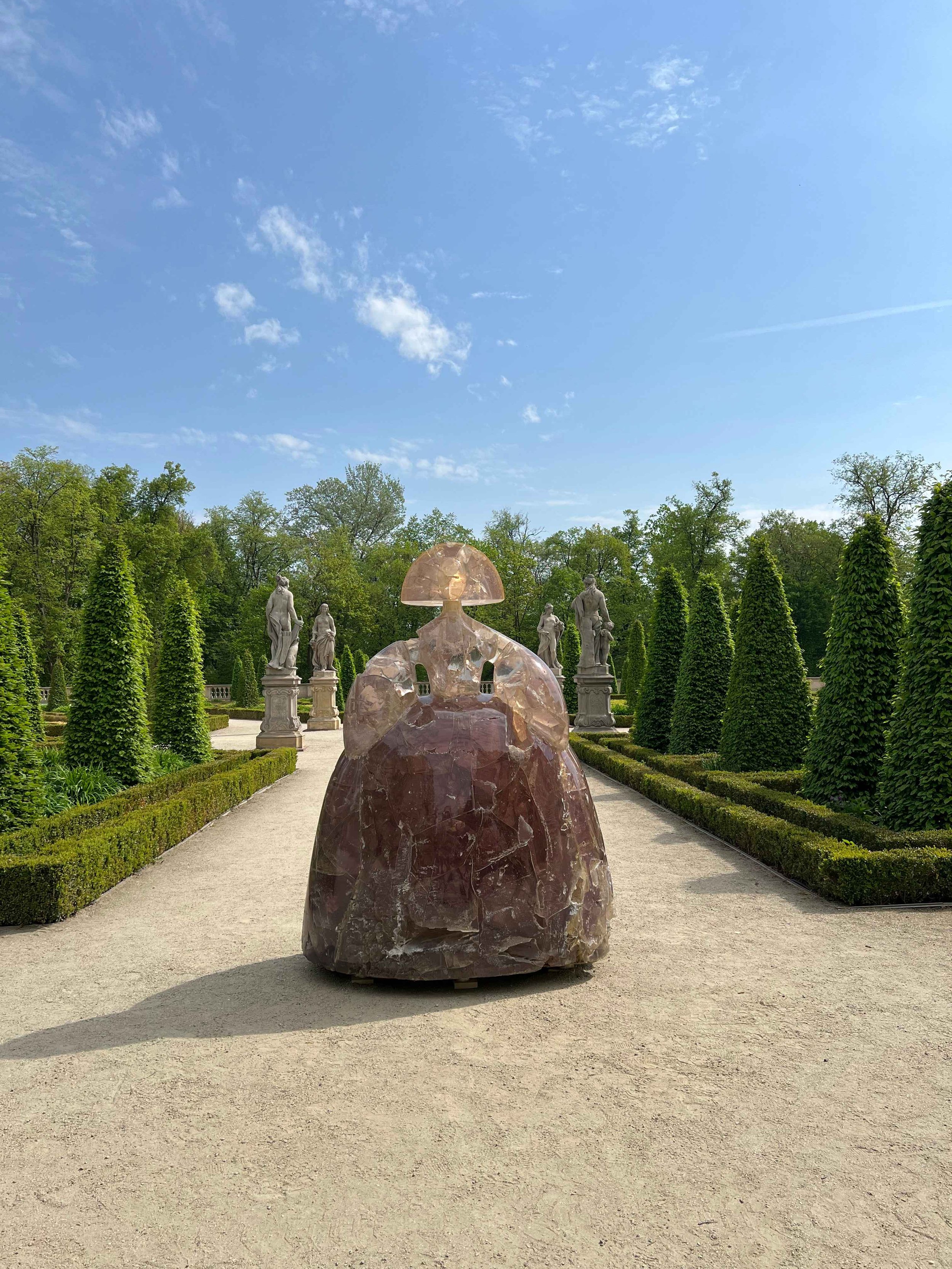
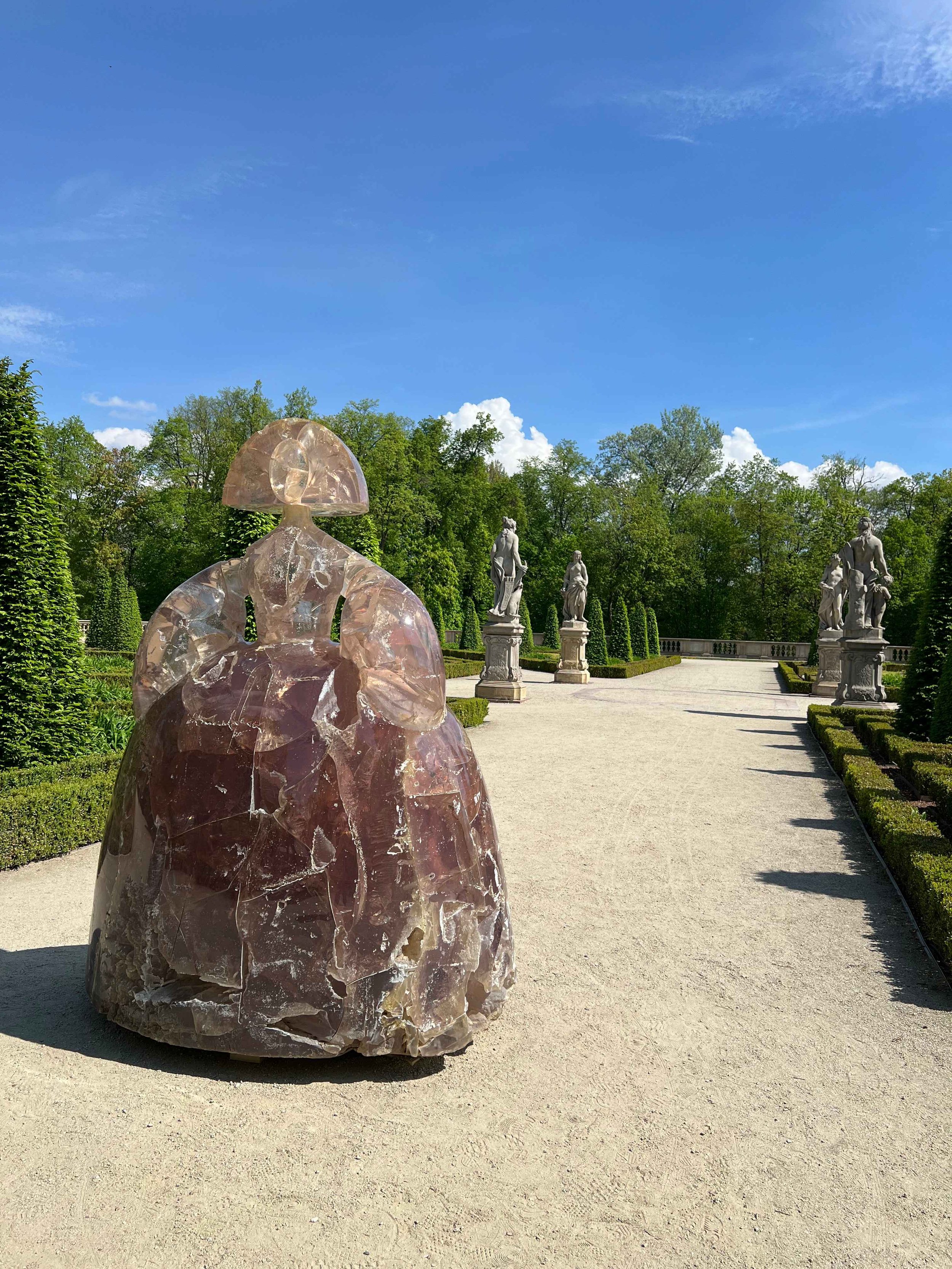
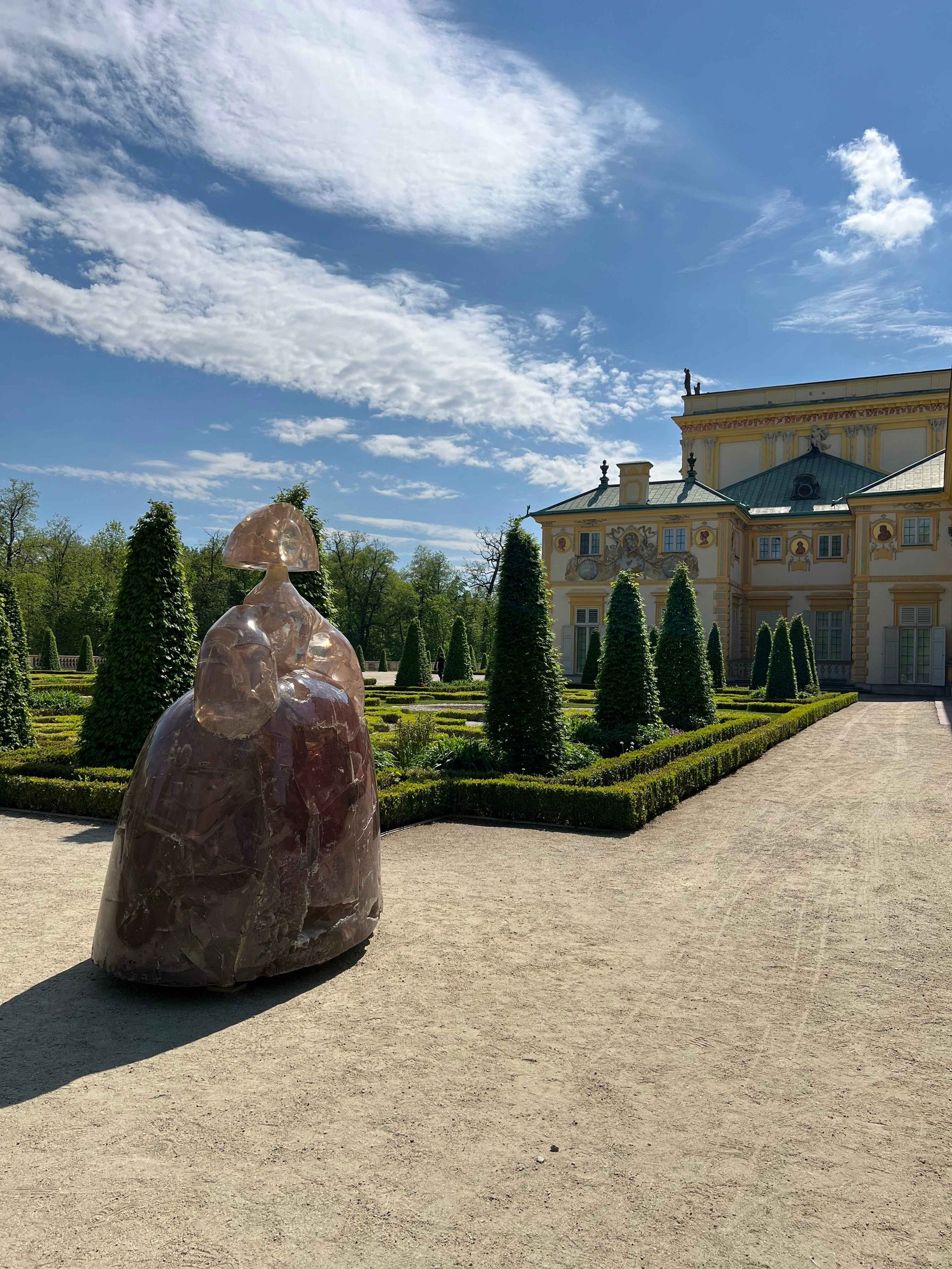
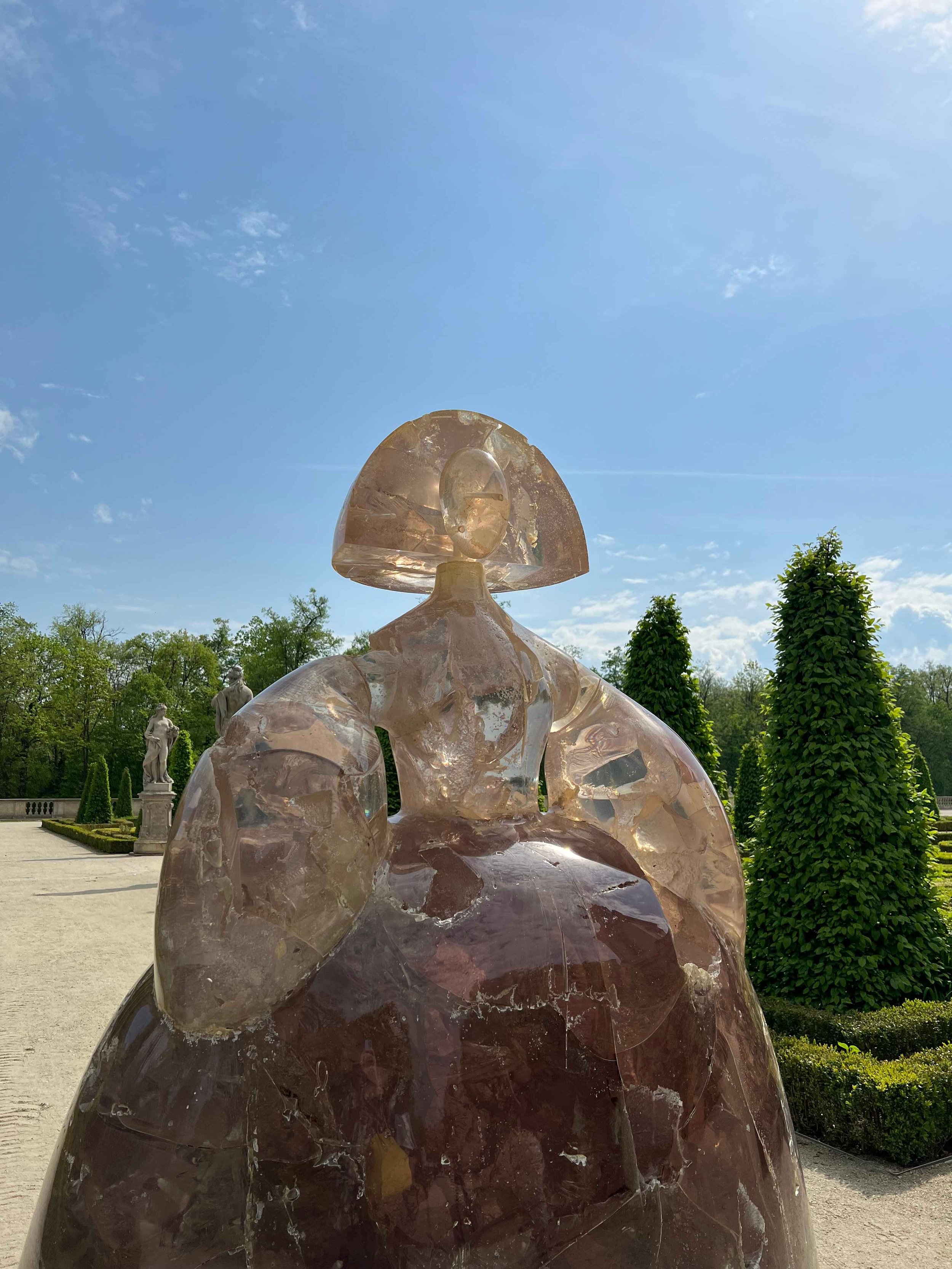
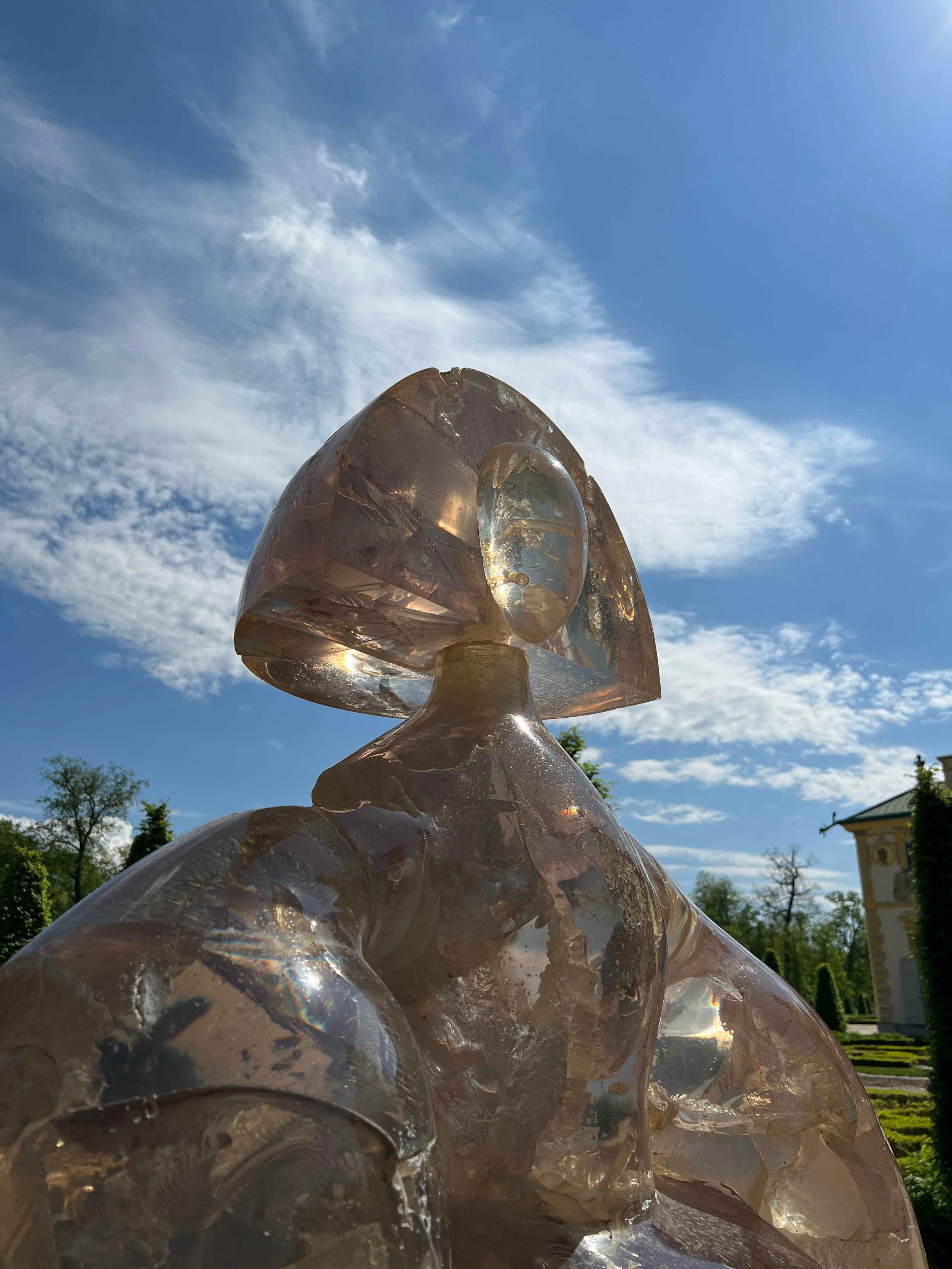
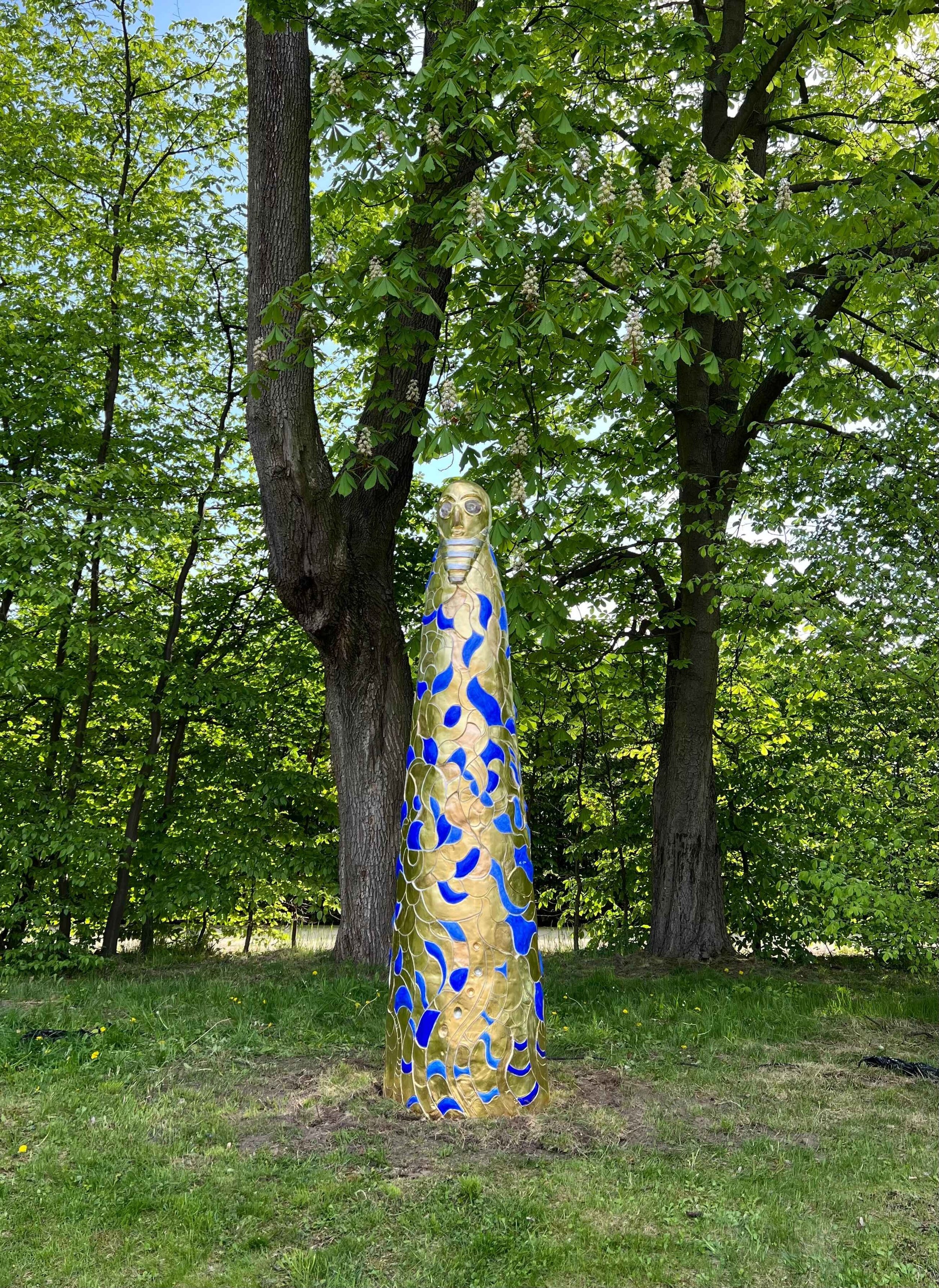
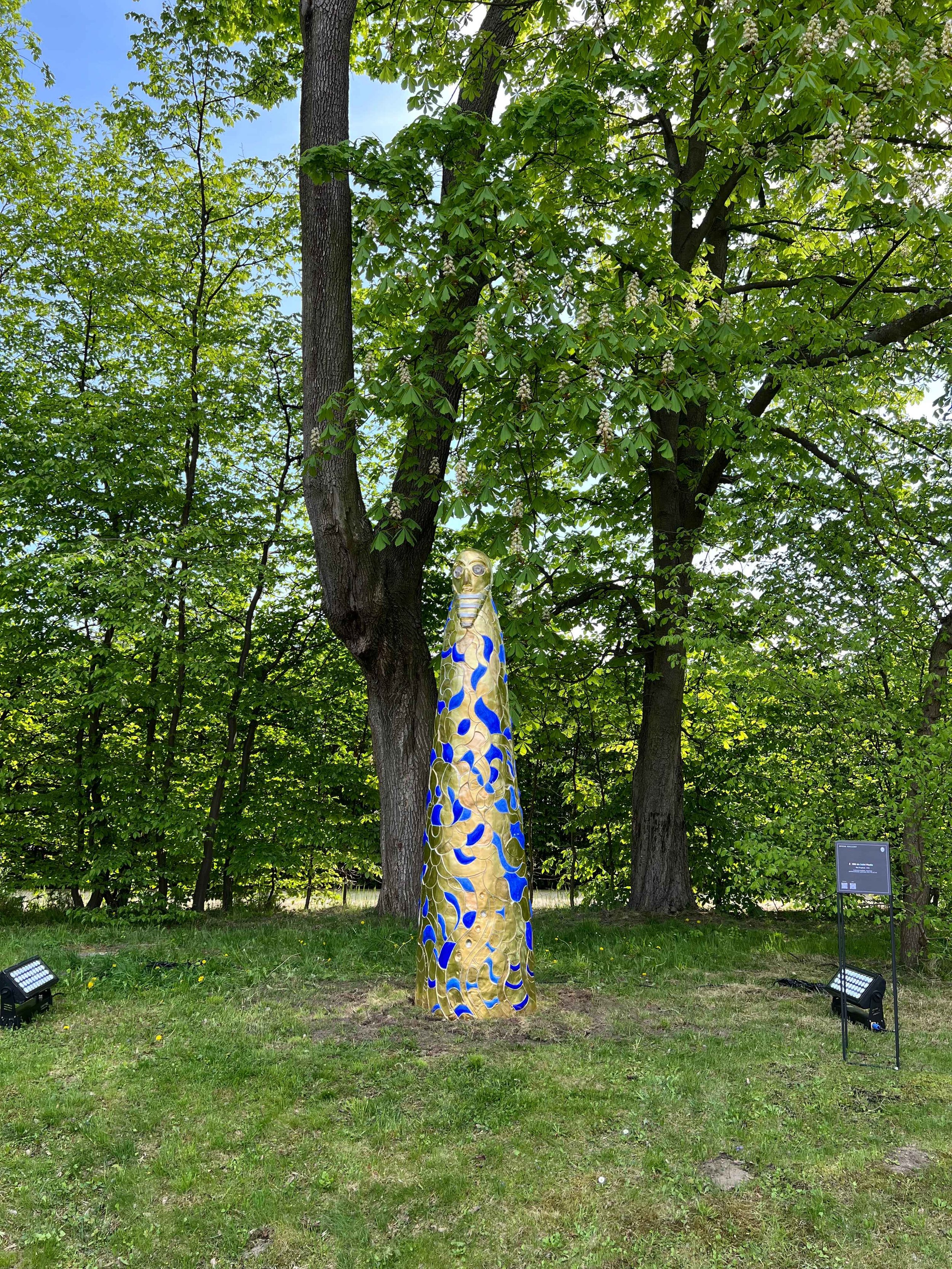
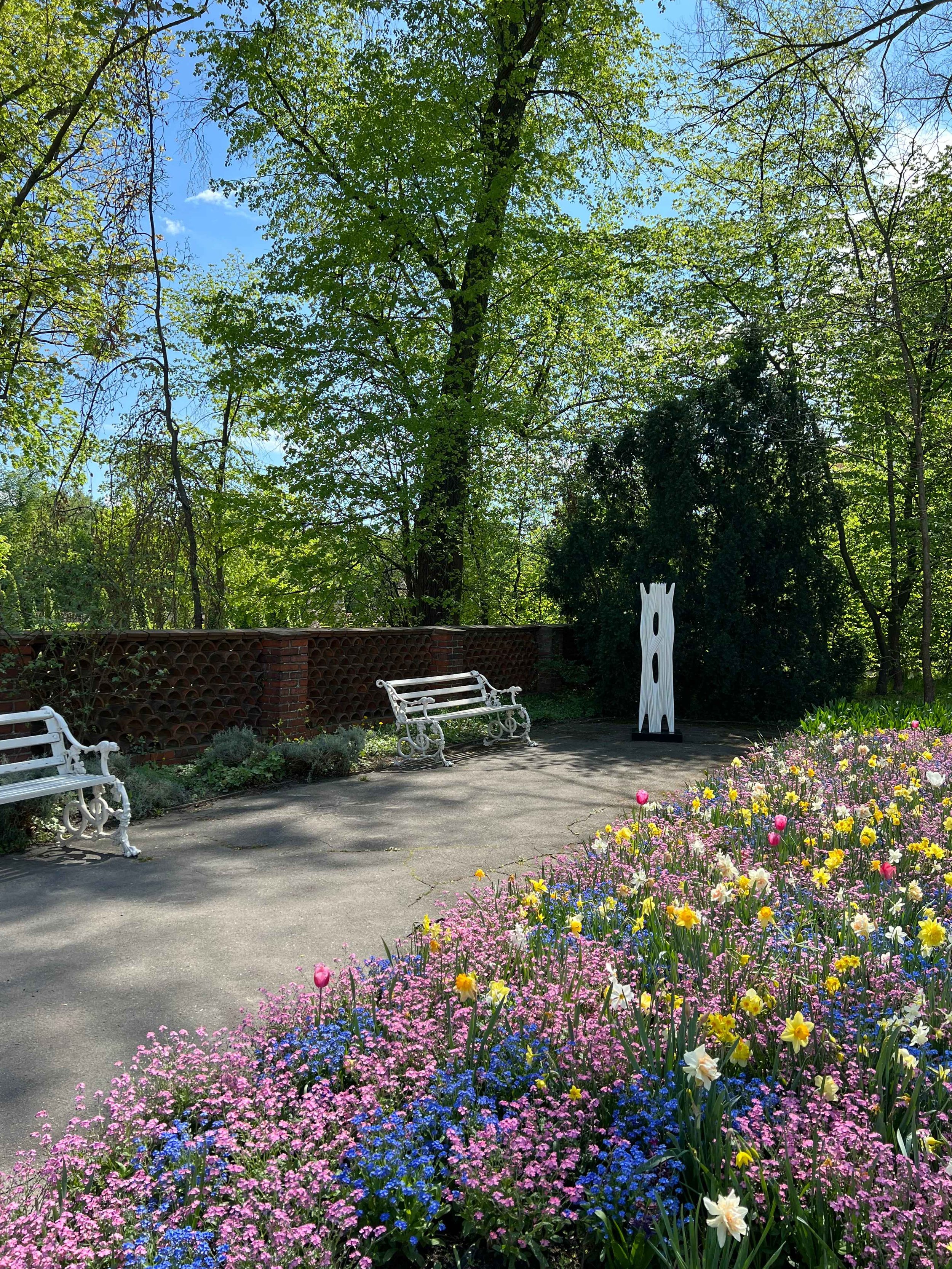
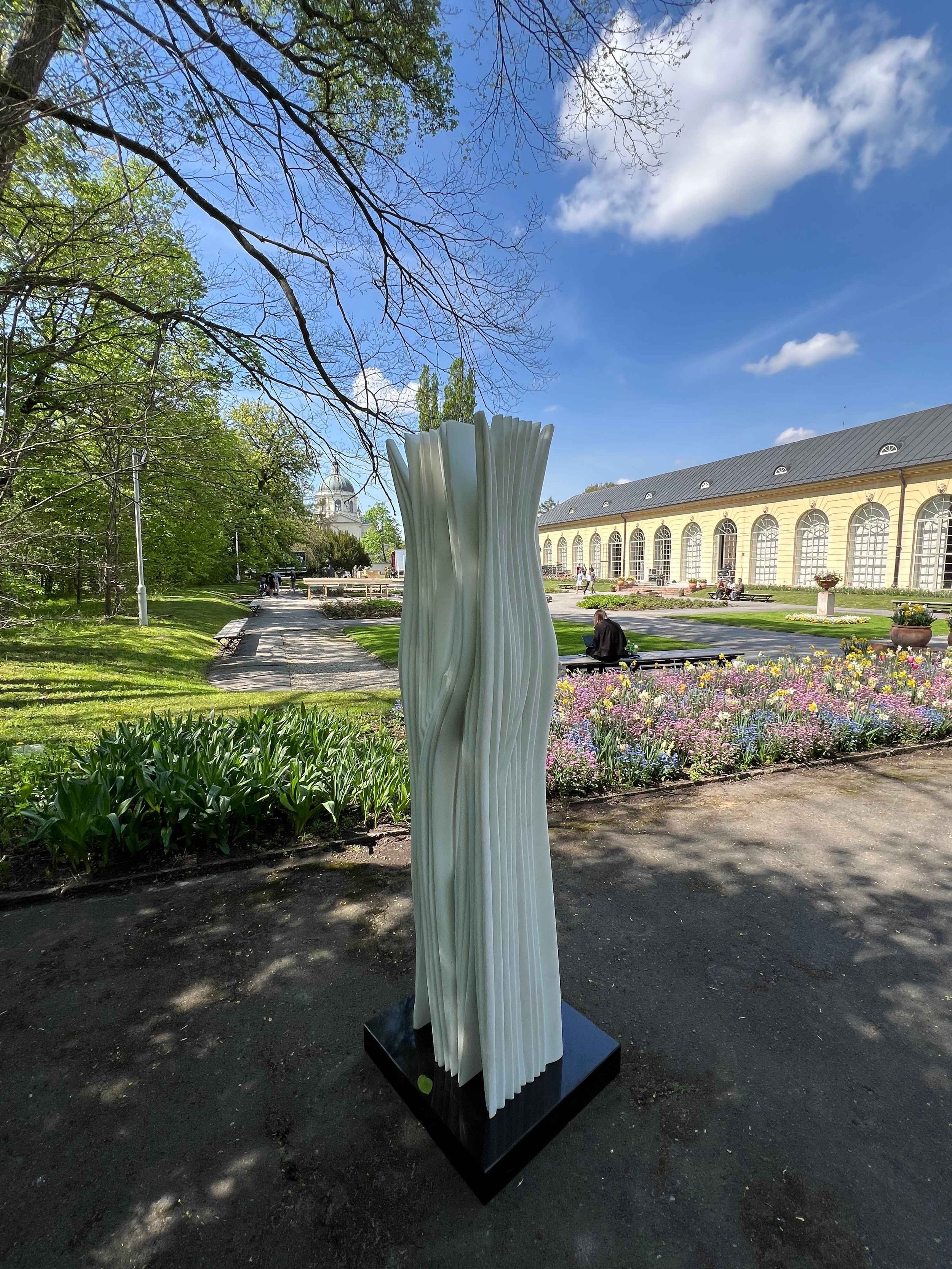
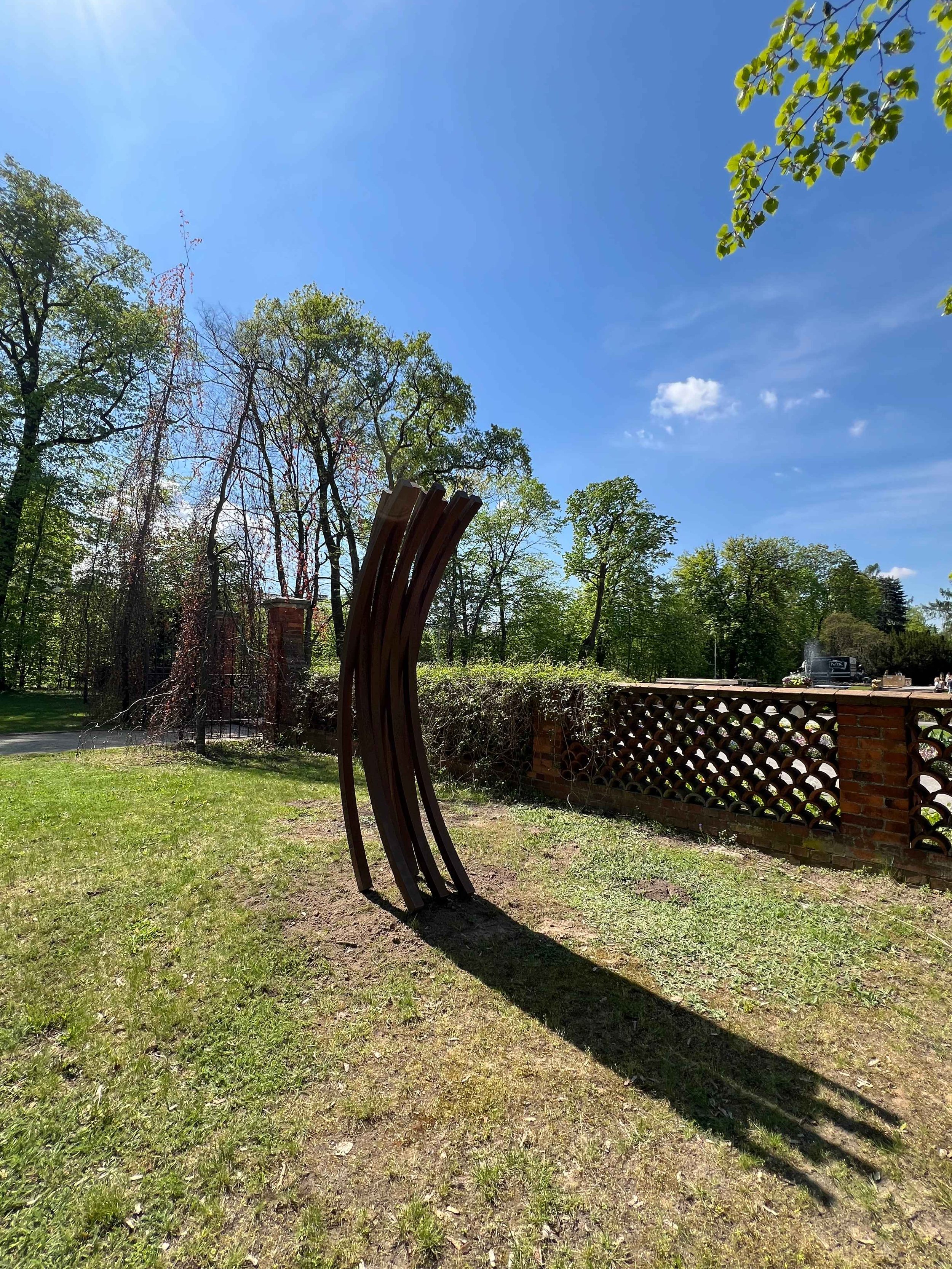

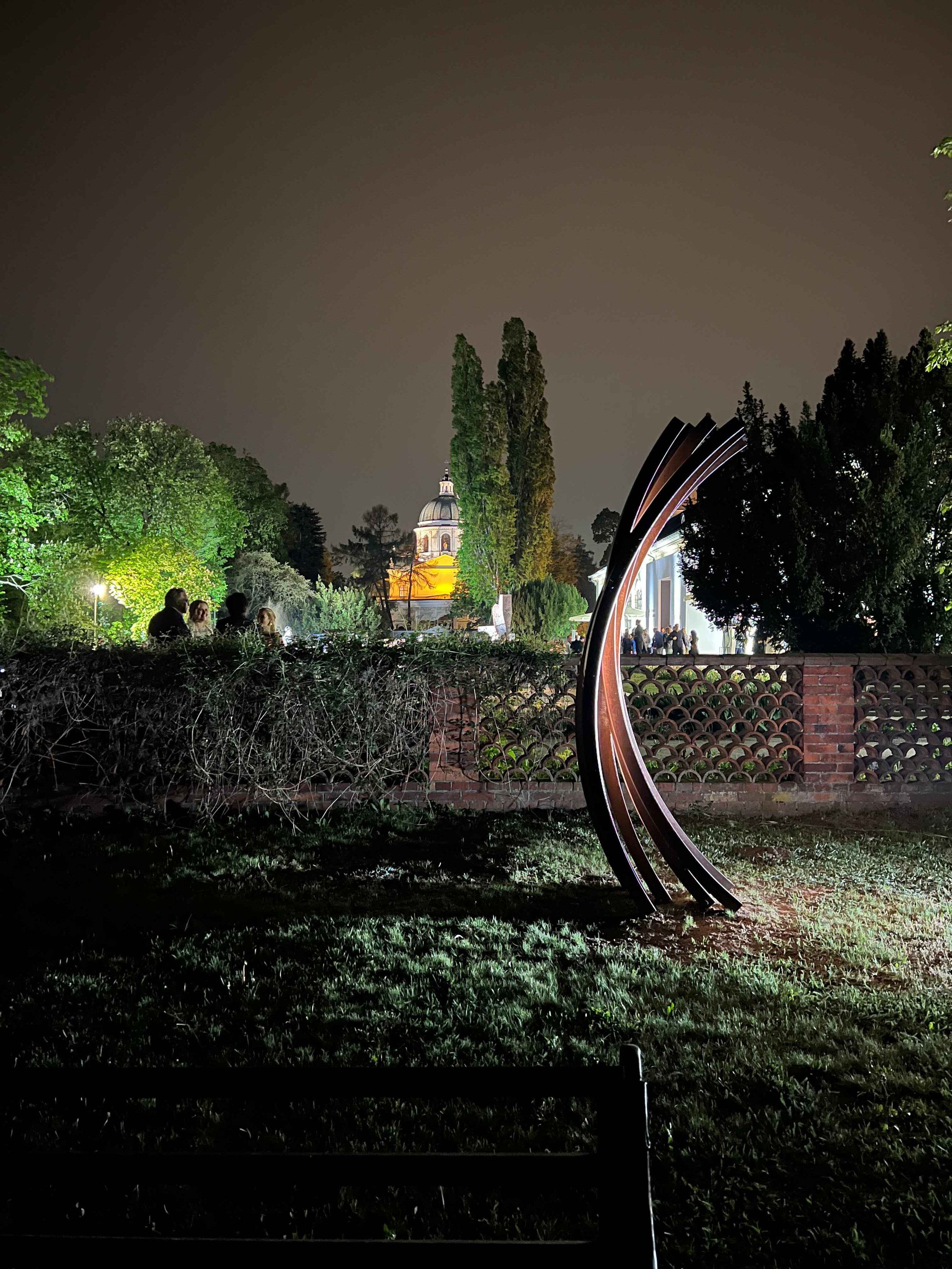
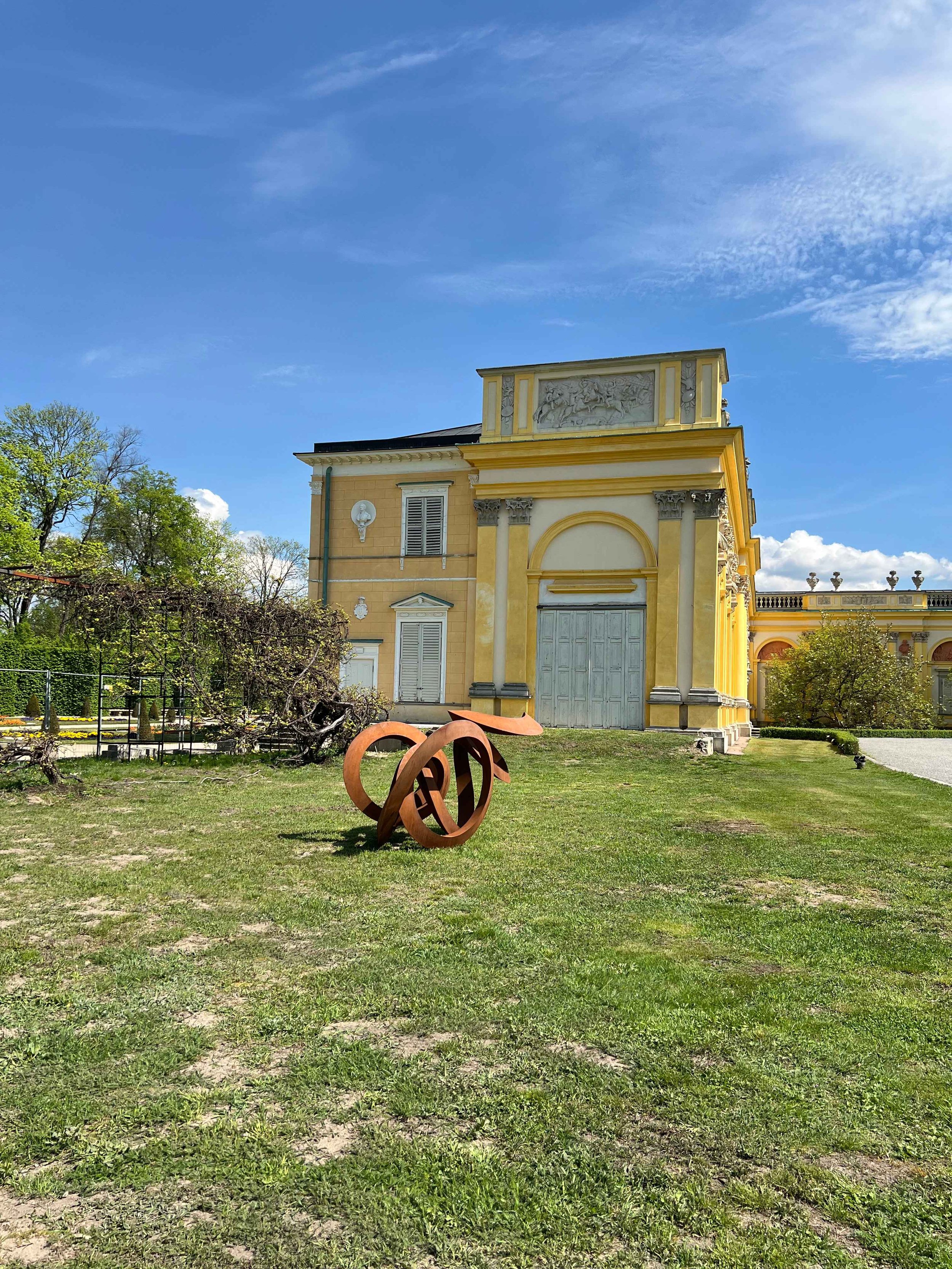

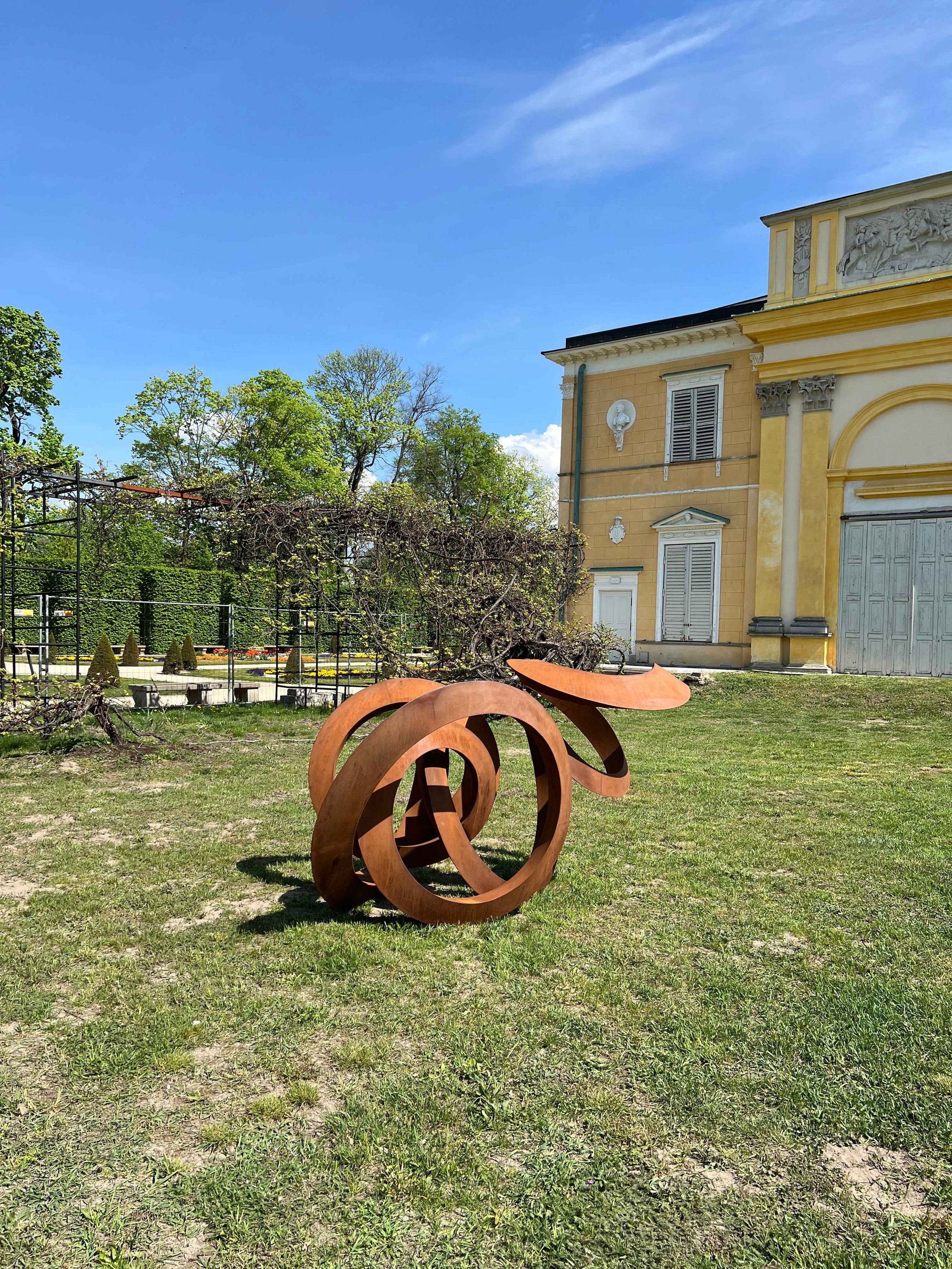
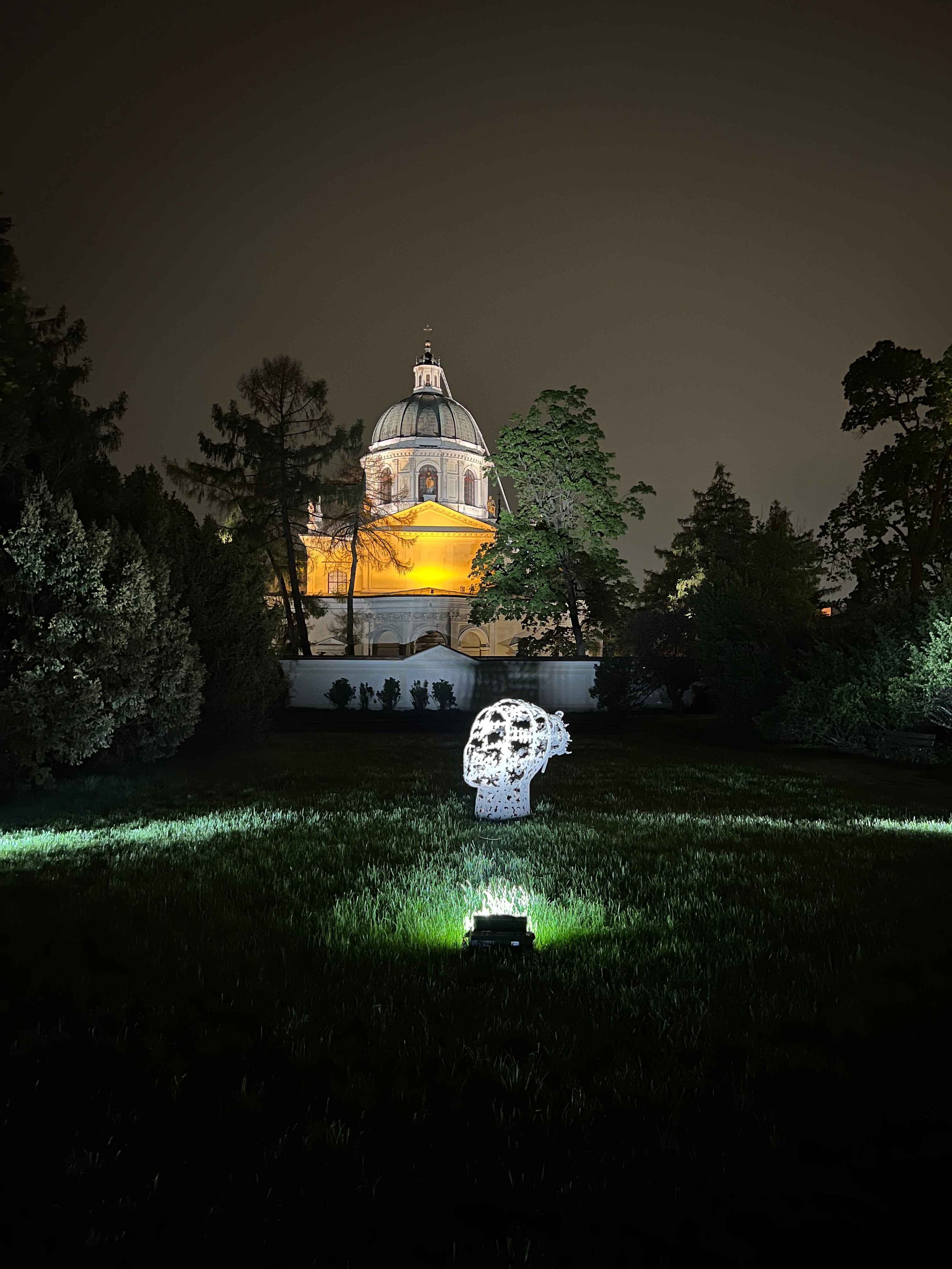
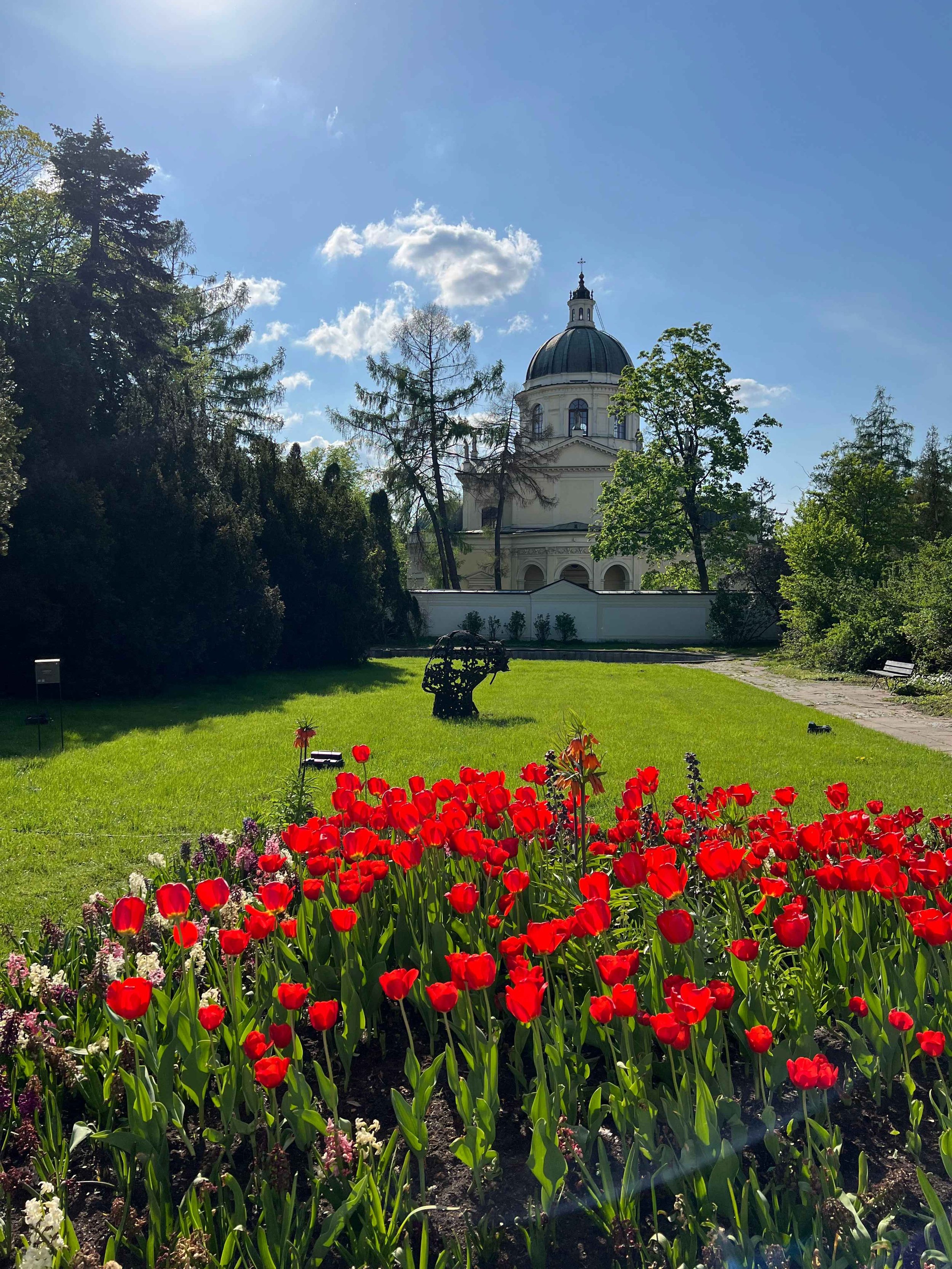

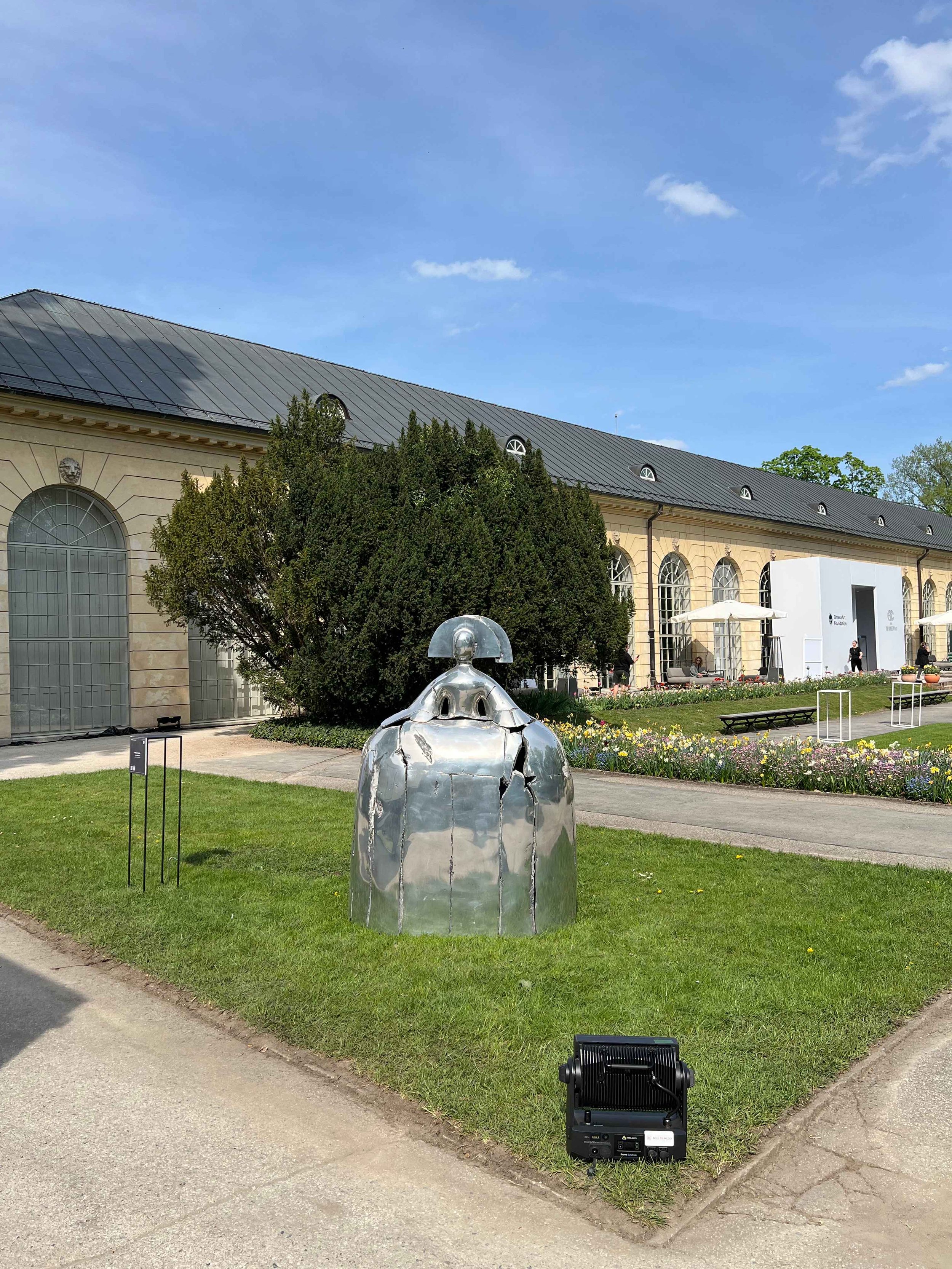
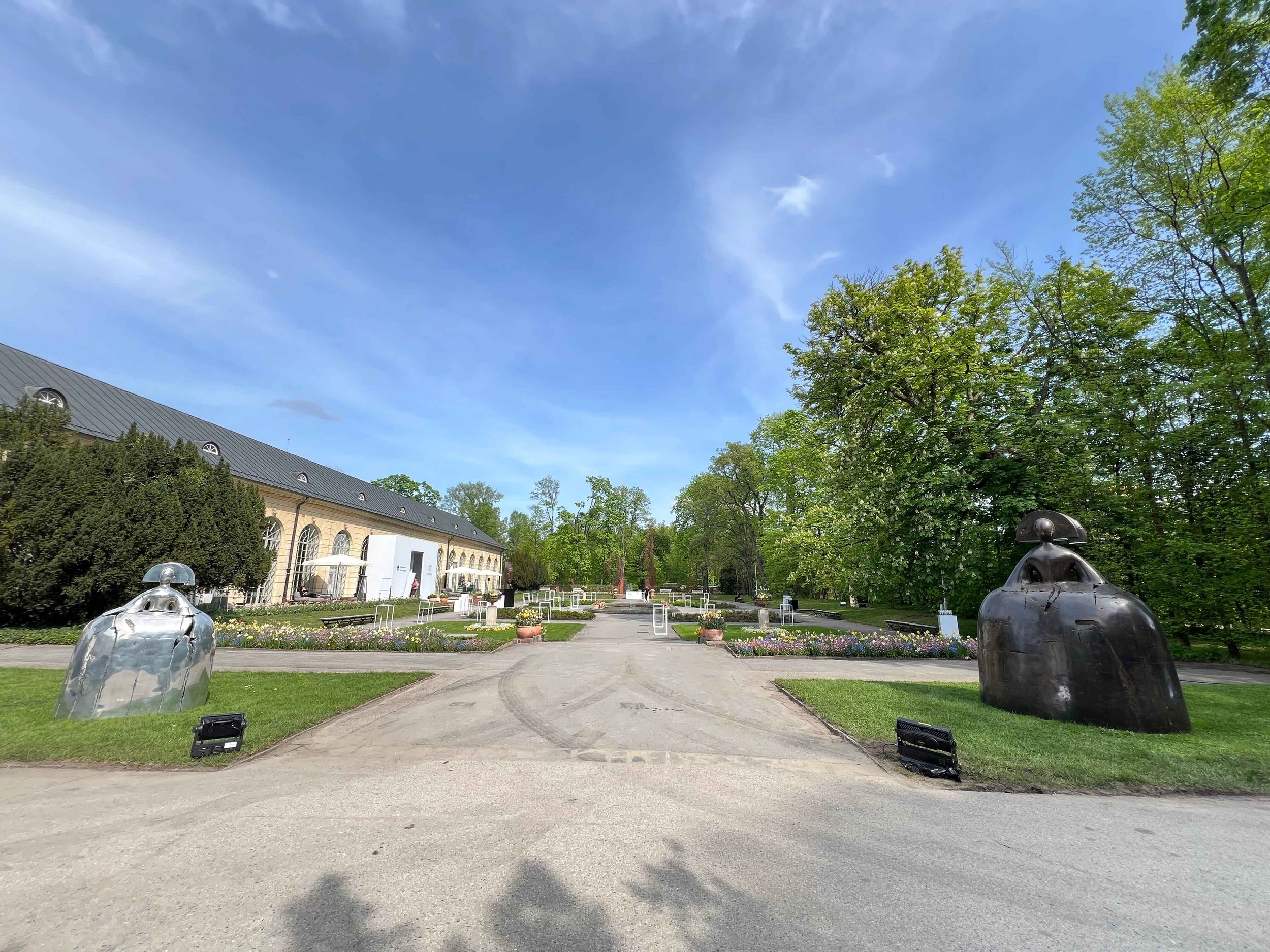

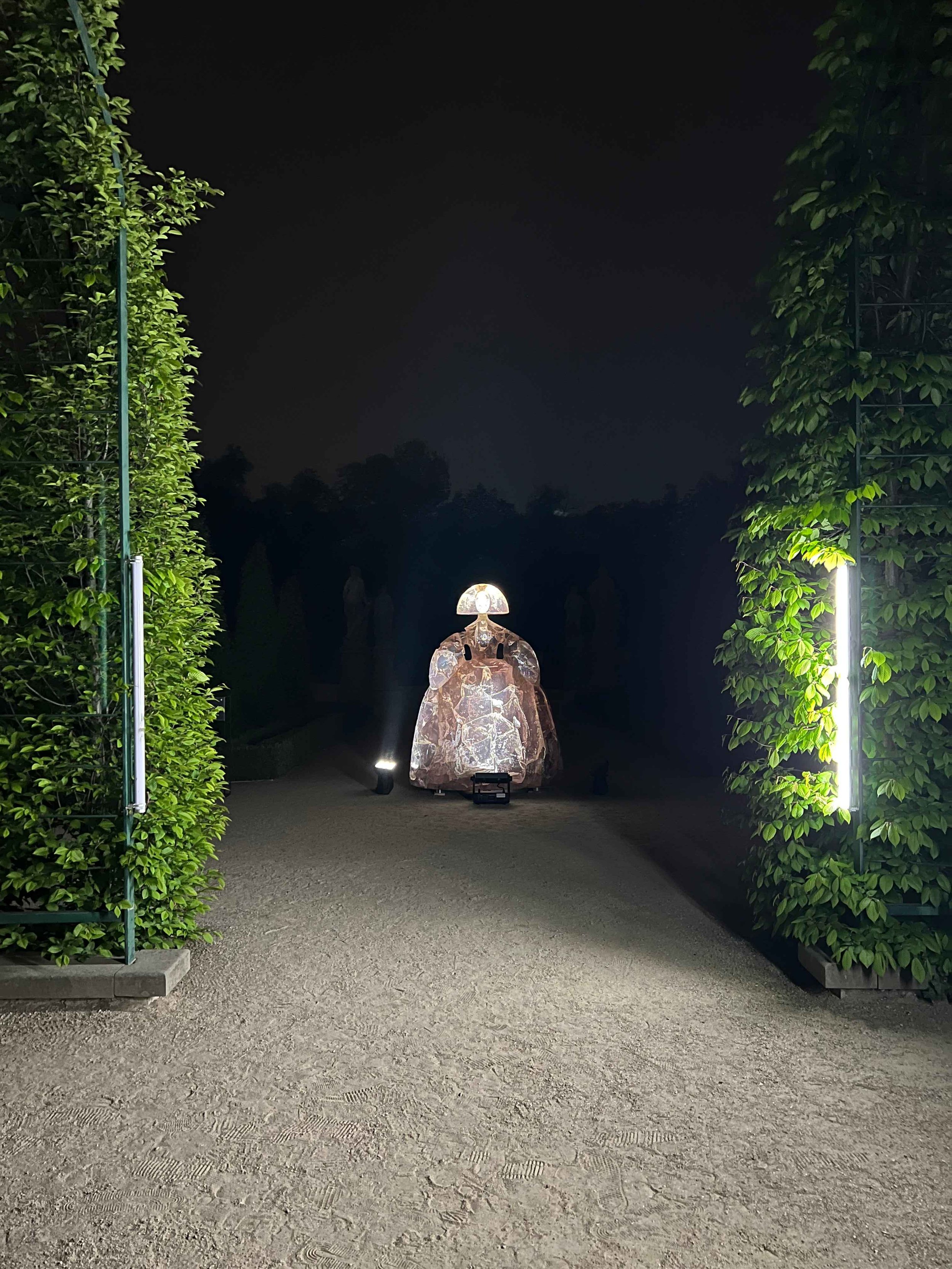
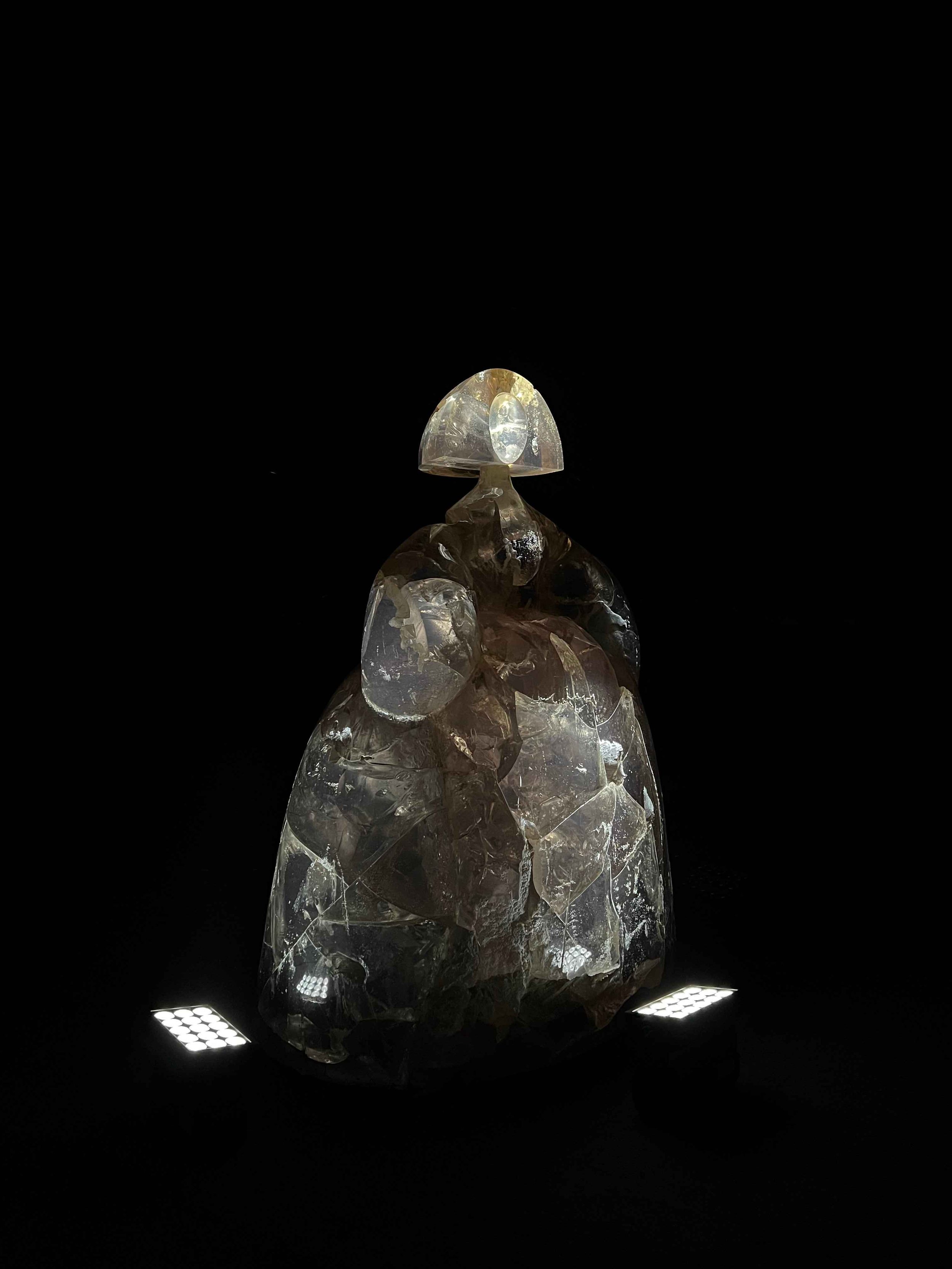

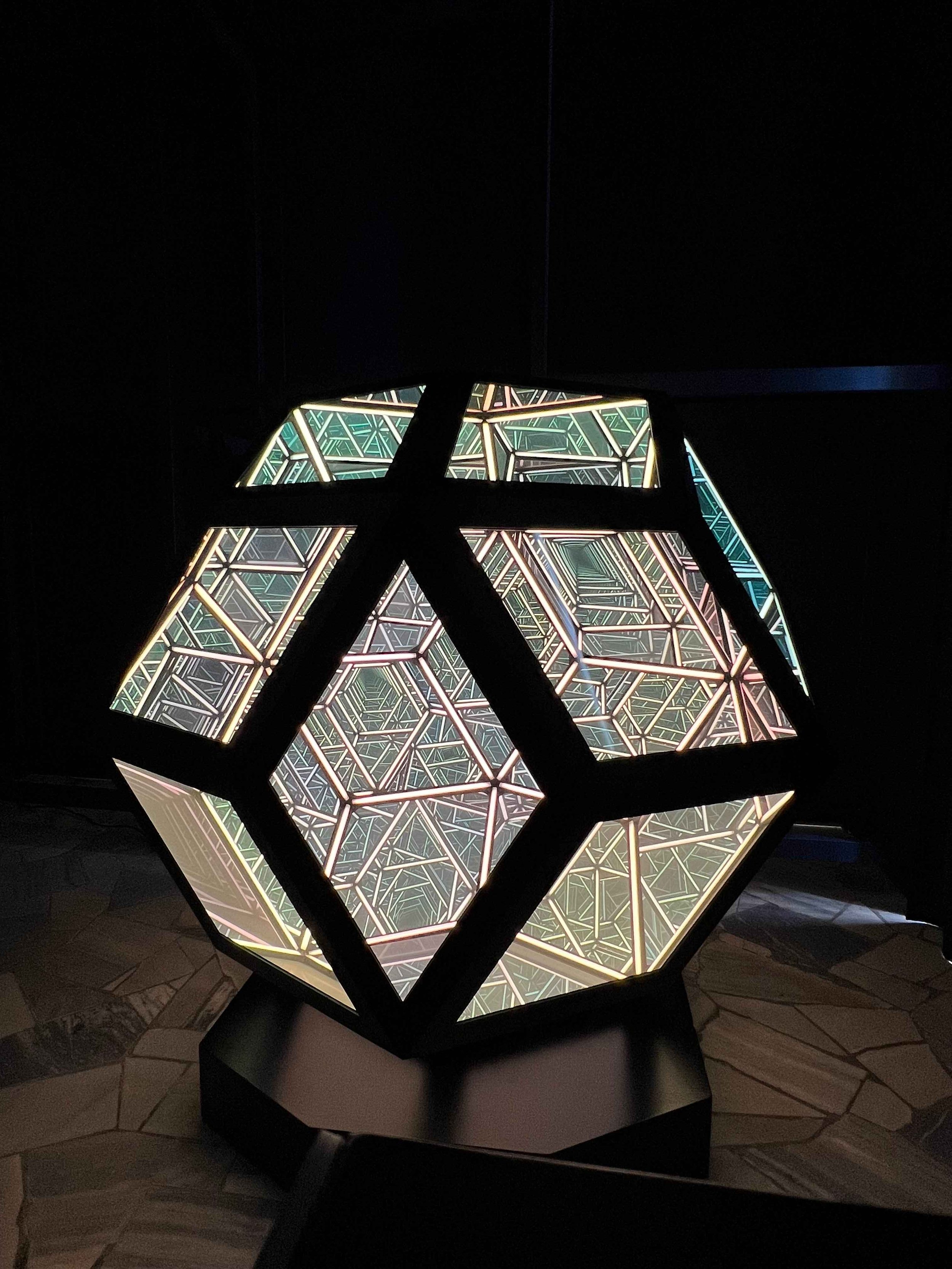
OmenaArt Foundation TOP CHARITY Sculpture Exhibition at Wilanów 2025
There is something generous and idealistic about public art. It can be about inspiration, amusement or serious reflection: but it is always art on a mission.
Across Europe and the world, sculpture comes out of the museum, the gallery and other elite places, to meet you in the public square, the park or where you least expect. Its purpose is to change the way you feel, and even sometimes how you think. It asks what is beautiful? What and who is important? What is worth remembering or celebrating? What needs to change? And sometimes it is simply an invitation to put away your worries for a moment, laugh, and have some fun.
The works selected for this year’s sculpture exhibition in the gardens of King John III's Palace Museum in Wilanów touch all of these registers.
Anthony James’s Portal sculptures are inspired by sacred geometry, the universal language of geometrical shapes and proportions echoing across nature and the cosmos, from the tiniest cell to the structures of the universe itself. These forms are encoded in our collective unconscious, shards of the kaleidoscopic totality of creation that we all recognise and intuitively relate to.
Exhibited across all seven continents, including in Antarctica, the Portals are made from titanium and glass veined with LED lights, a muscular fusion of technology and mysticism inviting the viewer to map their consciousness into this wider continuum of inner and outer, the spiritual and the manifest.
“As above, so below” goes the famous epithet that forms the foundation of hermetic thought on which both European and Islamic mysticism are based. It points to the connection between celestial energies and terrestrial events, and the actions of Earth, Wind, Fire and Water asserting their elemental characteristics over it all. The glyphs common to hermetic languages and symbolism, whether associated with traditional religion, spirituality or heresy, share a geometrical language transcending them all.
Gleaming like diamonds with a cosmic light, James’s Portals can be viewed through the Materialist traditions of Minimalist and Light Art, or as a tangible embodiment of immanence and the urge towards a syncretic understanding of our place in the grander scheme of things.
James’s cool and analytical approach to these complex and coded languages stands in fascinating contrast to that of Niki de Saint Phalle’s. Saint Phalle was a French-American artist who came to prominence in the 1960’s with her monumental and voluptuous “Nana” sculptures, celebrating female liberation, fertility and sexual freedom. These bold and colourful works were a rare intervention by a woman artist in public space in the twentieth century, asserting a feminist vision of a woman with the power and confidence to take up space and be seen, and by doing so they served a talismanic function for an artist deeply engaged with Hermetic symbolism and the Divine Feminine.
In the 1970’s, and inspired by her esoteric studies and the famous Marseille Tarot, she set out to create a magnificent and unique sculpture park, Il Giardino dei Tarocchi (The Tarot Garden) in Tuscany. The garden expands on the themes of personal transformation, ritual and spiritual journeys of transmutation, and The Prophet (1990) picks up on Saint Phalle’s fascination with the Major Arcana by evoking a figure with qualities reflecting the major Tarot archetypes of the Spiritual Teacher, The Truth Seeker and the Magician, a Shamanic fount of sacred knowledge and manifester of divine visions.
Using her characteristic combination of fibreglass and polyester resin permitted Saint Phalle to create lightweight but durable sculptures suitable for installation outside, with stable and highly pigmented surfaces embedded with glass, mosaic and other found objects.
Picking up on the themes of feminine presence and power, Manolo Valdés’s queens and princesses have their roots deep in the currents of European history and art patronage.
In the settings of the Wilanów Palace and gardens, Valdés’s sculptures of Reina Mariana and the Infanta Margarita find a very fitting home. Valdés has a passion for the baroque and the trappings of royalty, and is most famous for his series of works based on Diego de Velázquez’s portraits of the queens and princesses of the Spanish Royal court.
Here in the Baroque gardens at Wilanów, we meet Mariana of Austria, the second wife of King Philip IV of Spain, and her daughter the Infanta Margarita Teresa. Philip IV was Velázquez’s greatest patron and one of the most important monarchs of the Spanish Golden Age, and both Reina Mariana and Infanta Margarita are depicted in Velázquez’s most celebrated painting, Las Meninas. Indeed, Las Meninas is one of the greatest masterpieces the Spanish Baroque period.
In both cases, the silhouettes of the Queen and Infanta are enhanced, while the finer features of their face and dress are simplified to emphasise the overwhelming sensation of this regal female figure taking up space. In focusing on volume over expressive detail, he creates evocations of feminine power and nobility that are formidable and very present.
The sleek yet durable aluminium of Reina Mariana has light reflecting qualities that shine and play with their surroundings; whilst Infanta Margarita is rendered in resin, a more painterly material built up layer by layer, bringing a smoothness and organic qualities of skin and fabric. Both material choices jolt Velázquez’s 17th century into dialogue with the industrial materials and techniques of our time.
Pablo Achugarry’s work engages with the heritage and heroic traditions of classical and Renaissance marble carving, tapping this timeless seam to create works that pay homage to beauty, harmony and the equally enduring human yearning for transcendence.
His sculptures are physical evocations of spiritual longing and achieve their effect through a dedication to craft and technical virtuosity that, in the right hands, can transform the hardest block of marble into a vessel of movement and light.
At the essence of carving lies a sense of an inherent form contained within a block of stone, waiting to be discovered. This is the drive that Achugarry follows, interrogating the marble in a probing dialogue through which he divines its inner being. In this way, carving is a very physical kind of communication between the human body and the geological body of the earth.
Whilst two of his great heroes, the Ancient Greek sculptor Phidias and Michelangelo nearly two thousand years later, manifested the spiritual through depictions of deities and other figures, Achugarry translates this energy of spirit into abstract forms reaching upwards. The translucency of marble is both luminous and diaphanous, having the qualities and flow of fabric and water. In his hands, it creates a body of sculpture that for all its solidity appears to defy gravity and touch a higher consciousness.
Xavier Mascaro’s sculptures are a meditation on time, and of how we connect with the past through material culture and the narratives of history and myth. They bring to mind Milan Kundera’s observation that "man is separated from the past... by two forces that go instantly to work and cooperate: the force of forgetting (which erases) and the force of memory (which transforms)."
Material culture is the practice of using of artifacts, architecture and technologies of a particular age and place in order to understand cultures and societies, and how they respond to events. It is founded on the belief that the testament of objects – often interpreted through myth as well as empirical observation – illuminates the actions of history.
Mascaro’s choice of iron and bronze, metals that are constantly evolving and visibly aging, harnesses these organic processes to embed his sculptures in this sense of timelessness. He welcomes casting imperfections, as they underline the impermanence of even the most enduring of materials. There is an ambiguity to his series of Warriors, Guardians, Heads, and Boats – are they remnants from past civilisations or witnesses to our own age? By activating this uncertainty, they point to a universality of human experience.
The artist’s choice of medium – so infinitely varied and open today, with ancient knowhow and AI technologies sharing the common ground of creativity – has always been a crucial and deliberate matter. Between the eternal qualities of marble and the protean nature of technology, lies the poetic transience of metal; apparently solid, but ultimately unstable. Pieter Obels is inspired by organic and elemental forms found in the actions of wind and water, and in the natural world. His large, abstract sculptures are at home in the landscape because they are of the landscape, echoing its features and rhythms in the russet tones of Corten steel. They simplify and abstract, whether inspired by the arc of a tree or the arch of a tendril, the movement of a river or stillness of a lake, or the rush and whirl of the wind, which is felt but not seen.
The forces of nature meet with the power of industry in these large-scale sculptures. Obels bends steel to his will, smoothing and curving it. He chooses Corten because of its famously dynamic surface qualities, which are engineered to weather in a stable manner. Corten steel oxidises naturally when exposed to water and humidity.
By placing these sculptures outside, Obels invites the environment to complete them, letting the rain, wind and light act on their skin and leave their traces on them. The rate at which this happens reflects the climate the work is placed in, providing a metaphor for the action of time and the transformations it brings. His sculptures are a contemplative evocation of the perfection of nature, but also its inexorable erosion and decay.
Bernar Venet is a true polymath, whose creative activity takes in visual arts from sculpture, painting, photography and sound, to poetry and product design. To all, he brings a cerebral sensibility founded on an early conviction that art should focus on ideas rather than the creation of beautiful objects. It is interesting to observe that in spite of this, his output is notable for its elegance and poise, unintentionally (perhaps?) suggesting a direct correlation between beauty and clarity of thought.
Coming of age in post-war France, when Minimalism and Conceptual Art were at their most influential, Venet embraced mathematics, physics and geometry, incorporating formulas into his designs and giving them visual form through the use of industrial materials and processes. Inspired by the great engineering projects he witnessed as his country was rebuilt following the devastations of World War II, he took the vernacular of architectural elements and materials such as steel beams to produce monumental sculptures that stood in dialogue with the built environment. Starting life as drawings and digital designs, these towering arcs, angles, and straight lines embrace industrial processes, marrying Platonic ideals of objective truth with a profound engagement with their surroundings, whether urban or rural, standing as a species of tuning fork, resonating with the unique frequency of their settings.
Every work of art starts as an idea, by nature abstract: an idea which inspires action. By acting in the world, art has unparalleled power to affect it. Some works of public art have such power that over time they transform an entire region’s image of itself. A good example of this is Antony Gormley’s truly iconic Angel of the North, which in becoming an emblem for the Northeast of England, has also revitalised tourism and the economy of the region by creating a world famous destination that also honours its people’s past and industrial history. Whilst it may be hard to value in promotional terms, the exposure that some public works of art generate would cost millions in marketing and advertising, even when that is not its original intention. The sky’s the limit when it comes to sculpture. If you know what you’re doing, you can change the world.
Running from 24 April – 24 June 2025, the exhibition is a partnership between OmenaArt Foundation and the Opera Gallery.
